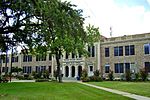Port of Houston
The Port of Houston is one of the world's largest ports and serves the metropolitan area of Houston, Texas. The port is a 50-mile-long complex of diversified public and private facilities located a few hours' sailing time from the Gulf of Mexico. Located in the fourth-largest city in the United States, it is the busiest port in the U.S. in terms of foreign tonnage and the busiest in the U.S. in terms of overall tonnage. Though originally the port's terminals were primarily within the Houston city limits, the port has expanded to such a degree that today it has facilities in multiple communities in the surrounding area. In particular the port's busiest terminal, the Barbours Cut Terminal, is located in Morgan's Point. The Port of Houston is a cooperative entity consisting of both the port authority, which operates the major terminals along the Houston Ship Channel, and more than 150 private companies situated along Buffalo Bayou and Galveston Bay. Many petroleum corporations have built refineries along the channel where they are partially protected from the threat of major storms in the Gulf of Mexico. The petrochemical complex associated with the Port of Houston is one of the largest in the world.
Excerpt from the Wikipedia article Port of Houston (License: CC BY-SA 3.0, Authors).Port of Houston
Manchester Street, Houston
Geographical coordinates (GPS) Address Nearby Places Show on map
Geographical coordinates (GPS)
| Latitude | Longitude |
|---|---|
| N 29.716666666667 ° | E -95.25 ° |
Address
Manchester Street 10064
77012 Houston
Texas, United States
Open on Google Maps






